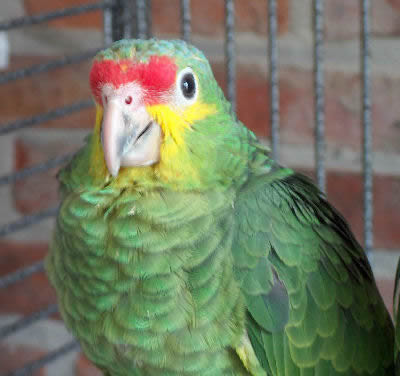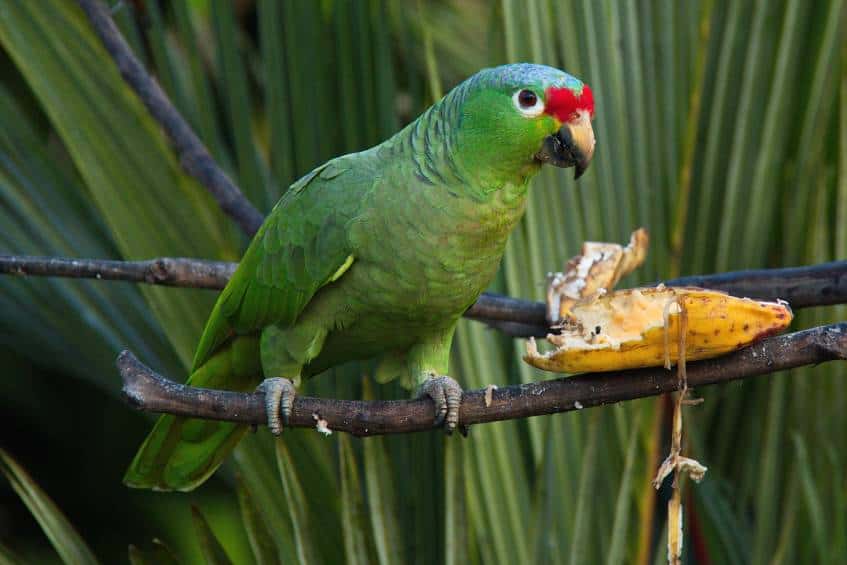
The Red-lored Amazon is a very attractive parrot, and simply loved for its “pretty face”!
The colorful face of the Red-lored Amazon Amazona autumnalis, also called the Yellow Cheek Amazon, has inspired many enthusiasts to proclaim it the most beautiful of the Amazons. it is readily apparent from this birds pretty face that these common names are quite fitting. Which ever name you prefer, the lores (and forehead) of this decorative Amazon are definitely red and its cheeks are definitely yellow.
This beautiful amazon is a pleasant, social parrot that enjoys its human companions. The Red-lored Parrot has an amiable personality, displaying less aggression than many of the other popular amazons. It is regarded as a wonderful pet bird that is gentle, affectionate and loyal. The Yellow Cheek Amazons are intelligent pet birds, quick and humorous at play, and you will enjoy their comical antics.
In the wild the Yellow Cheek Amazon is quite noisy within its flock, but in captivity it has been noted that they tend to be much quieter. Still this Amazon can be loud at times. Like all Amazons, they will call out an alert first thing in the morning and then again as the sun is setting. These two periods of the day usually last for about 10 minutes. Yet although the Red-lored Amazon parrots can be vocal they are not considered to be the best talkers. Depending on the individual bird, some will be good talkers while others will only say a couple of words.
The Red-lored Amazon parrots are very social and enjoy the company of people as well as other birds. They will form very strong bonds with their owner, becoming fast friends and exhibit total confidence. They are also a hardy robust bird and can do well in either a cage along with an out-of-the-cage playpen, or kept in an aviary.
For more information about Amazon Birds see:
Amazon Parrot: Information and Care
- Kingdom: Animalia
- Phylum: Chordata
- Class: Aves
- Order: Psittaciformes
- Family: Psittacidae
- Genus: Amazona
- Species: autumnalis
Scientific Name
Amazona autumnalis Subspecies:
- Red-lored Amazon
Amazona autumnalis autumnalis - Salvin’s Amazon
Amazona autumnalis salvini - Lilacine Amazon or Ecuadorian Red-lored Amazon
Amazona autumnalis lilacina - Diademed Amazon
Amazona autumnalis diadema
Distribution
The Red-Lored Amazon Amazona autumnalis was first described by Linnaeus in 1758. It is also called the Yellow Cheek Amazon and Red-lored Parrot.
Red-lored Parrots are found in Central America from eastern Mexico to the peninsula of Belize, Guatemala, and Honduras. They live in tropical zones where they inhabit the canopies of woodland and forest trees, and mangroves. They live in groups that can be small with as few as six birds, to large with up to a hundred birds, and form monogamous pairings during mating season. They feed on fruits, nuts, berries, seeds. and the blossoms and leafy buds of treetop foliage.
Status
The Amazona autumnalis is on the IUCN Red List for Endangered Species as Least Concern (LC).
Description
The Red-lored Amazon or Yellow Cheek Amazon has an overall green coloring. The lore and forehead are red, the crown is blue, and the cheeks are yellow. The wings are a spectacular array of color; green with red in the middle and blue on the outer edges and on the tips. The eye is dark brown with a white ring around it. The beak is gray but with a yellow horn color on the upper portion and the legs are greenish gray.
Juveniles will have less red on the lores and forehead, the cheeks may have some green, and the eye is orange. They become sexually mature at about 3 – 4 years. Mature birds are about 13 1/2 inches (34 cm) long from the top of the head to the tip of the tail. Their average lifespan is 40 to 60 years.
Care and feeding
In the wild these birds eat fruits, seeds, nuts, berries, blossoms and leaf buds, as well as enjoying some palm fruits. A pet bird will enjoy a varied diet, including a quality seed mix or a pelleted diet, and many fresh fruits and vegetables. Pellets will work if started at an early age. Plenty of human food that is nutritious can be offered. Avocado and chocolate are toxic to any parrot.
For more about the Amazon parrot diet, see Amazon Parrots: Care and Feeding
Housing
A roomy cage is required for the Red-lored Amazon. They are very active birds and need to spend a good deal of their time outside of their cage or can be housed in an aviary. A cage must not be too confining, so get one that your pet will be able to feel comfortable in. It is recommended that a cage be 2 x 3 feet wide and 2 1/2 to 5 feet high, and with a play pen top.
The Yellow Cheek Amazon likes to climb and play, and enjoys expanding its wings. It loves to be out of its cage on a playpen, and will enjoy interacting with their human as well as playing with toys. A hanging perch above the playpen is a great thing to have for climbing.
This Amazon can tolerate varying temperatures, but needs to be kept away from any drafts. A variety of perches should be used of varying size and texture. A rougher textured perch instead of the smooth, doll-rod types, makes it easier for them to perch and is better for their feet and legs. A concrete perch can be placed as the highest perch in the cage and next to a toy. At times during the day they will perch there and it will save them (and you) from the ordeal of having their nails filed.
Don’t forget bathing. Spraying your Red-lored Parrot with warm water or a commercially available bird bath is necessary to keep the feathers from drying out.
Maintenance
The basic cage care includes daily cleaning of the water and food dishes. Weekly you should wash all the perches and dirty toys, and the floor should be washed about every other week. A total hosing down and disinfecting of an aviary should be done yearly, replacing anything that needs to be freshened, such as old dishes, toys and perches
Social Behaviors
In the wild, the Red-lored or Yellow Cheek Amazons are very social birds. They are usually seen in groups, but with some distinct pairs in the group. Groups can be small with as few as six birds, to large with up to a hundred birds. These are social creatures, they like to be greeted when you come into the room. The more your amazon is around people, the more socialized it is and the more it will interact and play with you. You will establish a greater attachment between you and your feathered friend the more you are together.
Handling/Training
The Red-lored Amazon will adapt fairly rapidly, becoming accustomed to a new environment and its keeper. It is then ready to start bird training. Generally though, you should give a new arrival a few days to get use to you, your voice and its cage before trying to handle it. A hand fed baby will not need much taming and can often be handled right away, as it is use to human attention.
For information about training your Blue Front parrot see: Amazon Parrot Care: Handling and Training
Activities
The Red-lored Parrot is a very active amazon. It needs a lot of time out of its cage to stretch its wings, although climbing seems to be its favorite activity. It needs plenty of toys to keep it busy, and a hanging perch is thoroughly enjoyed. A moveable perch that can follow you around the house is also great. This Amazon likes to play, loves to wrangle with toys, and is quite an acrobat. They entertain themselves quite well and you will enjoy it.
Sexing – Sexual Differences
The Red-lored Amazon or Yellow Cheek Amazon is not sexually dimorphic. Females look like males. If gender identification is important (for example for breeding birds) DNA / Feather or surgical sexing is recommended.
Breeding/Reproduction
These amazons were first bred in captivity in the United States in 1956, but breeding successes have been variable. They become sexually mature at about three to four years and may raise more than one brood per year. They become sexually mature at about three to four years and may raise more than one brood per year. The sexes must be confirmed and the pair must be harmonious, bonded with each other. They will need a nest box that is 31″-39″ (80-100 cm) high with an inside diameter of 12″-14″ (30-35 cm) and an opening of 4″-5″ (10-12 cm). Provide some soft bedding material inside on the bottom of the box.
The hen will lay two to eight eggs which incubate for about 26 – 28 days. The young will leave the nest at about 12 weeks. As with many parrots, the male will eat for both himself and the female while she incubates the eggs and feeds the young. The male regurgitates the food for the female to eat. He gets a lot less picky about what he eats at these times!
Potential Problems
These birds are hardy and healthy if provided with a good environment and a good diet. Like all amazons, the Red-lored Amazon or Yellow Cheek Amazon can be noisy first thing in the morning and just before the sun sets. They have a loud piercing call, though many owners say their pets are relatively quiet. Amazons can often be quieted by just covering their cage for a short period of time. These parrots when well cared for will seldom become ill. Though it is often difficult to determine illness, some visible signs of illness to be aware of are:
- ruffled plumage
- listlessness
- drooping wings
- sagging body
- extreme mood changes
- having no appetite
- bulges in feathering
- partially closed or watery eyes
- swelling of the eyelids
- rasping
- difficulty breathing
- excessive saliva
- dirty vent
- any change in the feces not apparently diet related.
Some of the more common illnesses are:
- Psittacosis (chlamydiosis or parrot fever)
- bacterial, viral, or fungal infections
- feather picking (results of boredom, poor diet, sexual frustration, lack of bathing)
- allergies
- chewing flight and tail feathers by juveniles
- beak malformations in chicks
- Papillomas
- kidney disease (gout)
- toxicity
- heavy metal poisoning
- lipomas in older birds.
If you notice any of these bird illnesses in your Red-lored Amazon, immediately provide a warm, draft free, secure environment kept at about 86°F (30°C). Place food and water close to the perch where it is easily accessible. An ailing parrot should be taken to a avian veterinarian for diagnosis and treatment.
Availability
The Red-lored Amazon or Yellow Cheek Amazon is occasionally available in pet stores or from breeders in your area.
References
- Animal-World References: Pet Birds – Exotic Birds.
- Dr. David Alderton, The Atlas of Parrots of the World, T.F.H. Publications, Inc. 1991
- David Alderton, Parrots, Salamander Books, 1999
- Werner and Susanne Lantermann, Amazon Parrots, Barron’s Educational Series, Inc. 1988
- The Red Lored Amazon Parrot, Southeast Texas Avian Rescue, copyright 2004
Featured Image Credit: Karel Stipek, Shutterstock
